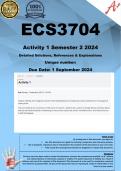ECS3704
Activity 1 Semester 2 2024
Detailed Solutions, References & Explanations
Unique number:
Due Date: 1 September 2024
Terms of use
By making use of this document you agree to:
• Use this document as a guide for learning, comparison and reference purpose,
• Not to duplicate, reproduce and/or misrepresent the contents of this document as your own work,
• Fully accept the consequences should you plagiarise or misuse this document.
Disclaimer
Extreme care has been used to create this document, however the contents are provided “as is” without
any representations or warranties, express or implied. The author assumes no liability as a result of
reliance and use of the contents of this document. This document is to be used for comparison, research
and reference purposes ONLY. No part of this document may be reproduced, resold or transmitted in any
form or by any means.
, +27 67 171 1739
Bureaucrats, driven by incentives such as increased power, prestige, and budget size,
often aim to maximize their budgets. This behavior can lead to the oversupply of public
goods, as depicted in the diagrams.
1. Diagram (a): Total Social Cost (TSC) and Total Social Benefit (TSB):
o The diagram shows that at the socially optimal level of public goods, Q0
, the gap between TSB and TSC is maximized, indicating the greatest
net benefit to society.
o Bureaucrats, however, push the provision of public goods to Q1, where
TSB equals TSC, but at a point where marginal social cost (MSC)
exceeds marginal social benefit (MSB).
2. Diagram (b): Marginal Social Cost (MSC) and Marginal Social Benefit
(MSB):
o The intersection of MSC and MSB at point EEE indicates the socially
optimal level Q0.
o Bureaucratic maximization shifts production to Q1, where the area
EGFEGFEGF represents a welfare loss, as MSC exceeds MSB by the
distance FG.
Disclaimer
Extreme care has been used to create this document, however the contents are provided “as is” without
any representations or warranties, express or implied. The author assumes no liability as a result of
reliance and use of the contents of this document. This document is to be used for comparison, research
and reference purposes ONLY. No part of this document may be reproduced, resold or transmitted in any
form or by any means.




